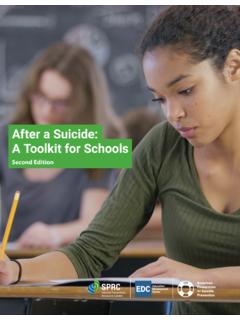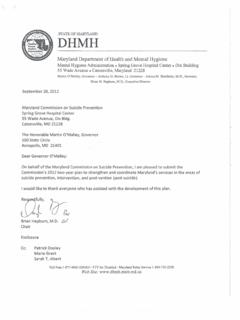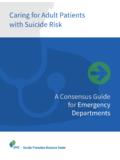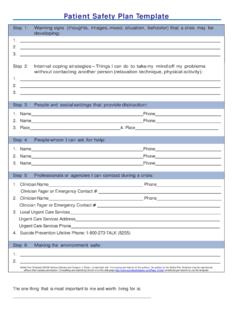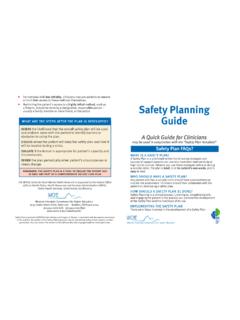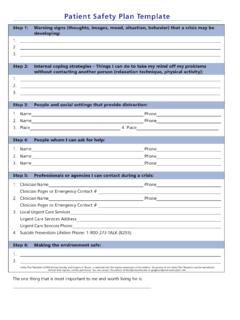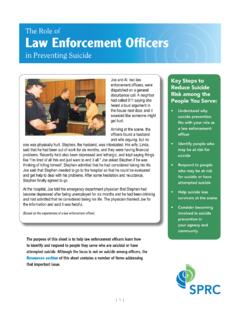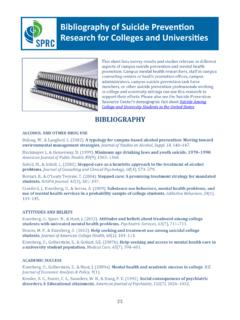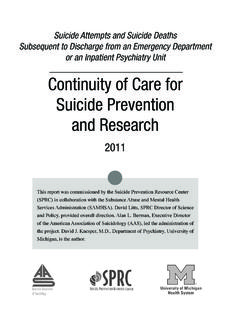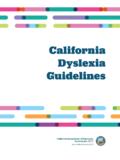Transcription of After a Suicide: A Toolkit for Schools 2nd Edition - SPRC
1 After a suicide : A Toolkit for Schools Second Edition suicide Prevention Resource Center Endorsements from Other Organizations National Association of school Psychologists (NASP). When a suicide occurs, it can disrupt the foundation of the school and larger community to the core. How school leaders respond can help minimize negative effects and reinforce resilience. In fact, effective postvention efforts serve as the first line for prevention of potential suicide contagion among vulnerable members of the school community. After a suicide : A Toolkit for Schools provides step-by-step guidance, templates, and resources all in one place. It is a vital resource to help school administrators and crisis teams plan for and implement appropriate postvention strategies to facilitate communications, support grieving students and staff, identify at-risk individuals, and more. National Association of secondary school Principals (NASSP).
2 The tragedy of suicide affects many Schools each year, and it is essential for principals and other school leaders to have the resources they need to help them cope personally and professionally in the event of a student death. During the high-stress period After a suicide , these professionals must provide effective postvention (activities that reduce risk and promote healing After a suicide death) and facilitate an orderly return to the daily operation of the school . That's why the National Association of secondary school Principals (NASSP) collaborates with organizations like the American Foundation for suicide Prevention and the suicide Prevention Resource Center. Toolkits like After a suicide : A Toolkit for Schools provide our members with tools and resources designed to help them work with faculty, staff, students, and others to restore the health of the school community. Resources like these are integral in helping principals and other school leaders carry out their mission to serve all students.
3 American school Counselor Association (ASCA). A student suicide has a tremendous impact on the entire school as well as the broader community. school administrators, faculty, and staff are called on to provide leadership and strength to students and their families, even though they themselves may be shaken emotionally and unsure of the proper actions to take. They will be grappling with issues such as immediate crisis response, helping students and parents cope, and communicating with the school and wider community, as well as the media. After a suicide : A Toolkit for Schools , developed by the American Foundation for suicide Prevention and the suicide Prevention Resource Center, is a valuable guide to help school personnel prepare for the tumultuous and stressful aftermath of a student suicide and to help prevent future tragedies. After a suicide : A Toolkit for Schools | ii This second Edition of After a suicide : A Toolkit for Schools was written in 2018 by the American Foundation for suicide Prevention (AFSP) and the suicide Prevention Resource Center (SPRC), Education Development Center (EDC).
4 Authors of the Second Edition Scott Poland, EdD. Professor, College of Psychology, and Co-Director, Doreen S. Marshall, PhD. suicide and Violence Prevention Office, Nova Vice President of Programs, AFSP. Southeastern University, Fort Lauderdale, FL. Christine Moutier, MD. Jonathan B. Singer, PhD, LCSW. Chief Medical Officer, AFSP. Associate Professor, Loyola University school of Social Laurie B. Rosenblum, MPH Work, Chicago, IL; Founder and Host, Social Work Podcast Research Associate/Writer, SPRC. Christine Miara, MS. Contributors of Vignettes for the Former Director of Communications Second Edition and Resources, SPRC Elaine de Mello, LCSW. Training and Services Manager, Connect suicide Marc Posner, PhD. Prevention Program, National Alliance on Mental Illness Senior Writer/Editor, SPRC. NH, Concord, NH. Reviewers of the Second Edition Shashank V. Joshi, MD. Director of school Mental Health, Division of Child &. Terri A.
5 Erbacher, PhD. Adolescent Psychiatry, Stanford University school of school Psychologist, Delaware County Intermediate Unit, Medicine, Stanford, CA. Morton, PA; Clinical Associate Professor, Philadelphia College of Osteopathic Medicine, Philadelphia, PA Sarah Estes Merrell, MA. school Counselor, St. Ignatius College Prep, Madelyn Gould, PhD, MPH. San Francisco, CA. Professor of Epidemiology (in Psychiatry), Columbia University Medical Center, New York, NY Jeremiah Simmons, MPH, MS. PhD Candidate, RWJ Fellow, Program in Clinical John R. Jordan, PhD. Psychology, Robert Wood Johnson Center for Health Clinical Psychologist, Private Practice, Pawtucket, RI. Policy at the University of New Mexico, Albuquerque, NM. Richard Lieberman, MA, NCSP. Erika Zepeda, MA, MEd Lecturer, Graduate school of Education at Loyola school Psychologist, Palo Alto High school , Palo Alto, CA. Marymount University, Los Angeles, CA. David N. Miller, PhD.
6 Associate Professor of school Psychology, Department of Educational & Counseling Psychology, University at Albany, State University of New York, Albany, NY. After a suicide : A Toolkit for Schools | iii Authors of the First Edition and Madelyn Gould, PhD, MPH. Professor of Clinical Epidemiology (in Psychiatry), Their Affiliation at the Time of Deputy Director of Research Training Program in Child Publication (March 2011) Psychiatry, New York State Psychiatric Institute, Columbia AFSP Co-Chair, Joanne L. Harpel, JD, MPhil University, New York, NY. Senior Director for Public Affairs and Postvention, AFSP. Christopher Gandin Le, MA. SPRC Co-Chair, Peggy West, PhD, MSW CEO, Emotion Technology LLC, Austin, TX. Senior Advisor, SPRC. Robert Macy, PhD. Gayle Jaffe, MSW, MPH Director, International Center for Disaster Resilience Senior Prevention Specialist, SPRC and Executive Director, Boston Children's Foundation, Boston, MA.
7 Donna Amundson, LCSW. Program Manager, Traumatic Loss Coalitions for Youth Elizabeth McCauley, PhD. Program, UMDNJ-University Behavioral Health Care, Professor of Psychiatry and Behavioral Science, Piscataway, NJ University of Washington, Seattle, WA. George Scott, EdS, MFT. Primary Reviewers of the First Middlesex County Coordinator, Traumatic Loss Coalitions Edition for Youth Program, UMDNJ-University Behavioral Health Care, Newark, NJ. Annette Beautrais, PhD. Senior Research Scientist, Yale University school of Frank Zenere, EdS. Medicine, New Haven, CT school Psychologist and District Crisis Management Specialist, Miami-Dade Public Schools , Miami, FL. Karen Dunne-Maxim, MSN, RN. Everest Consulting Associates, Princeton Junction, NJ. For additional first Edition acknowledgments, see Appendix C: Additional Reviewers of the First Edition . After a suicide : A Toolkit for Schools | iv After a suicide : A Toolkit for Schools addresses Objective of the National Strategy for suicide Prevention (2012): Develop guidelines for effective comprehensive support programs for individuals bereaved by suicide and promote the full implementation of these guidelines at the state/territorial, tribal, and community levels.
8 This document was funded by the American Foundation for suicide Prevention (AFSP) and the suicide Prevention Resource Center (SPRC). SPRC at EDC is supported by a grant from the Department of Health and Human Services (HHS), Substance Abuse and Mental Health Services Administration (SAMHSA), Center for Mental Health Services (CMHS), (Grant No. 5U79SM062297). The views, opinions, and content expressed in this product do not necessarily reflect the views, opinions, or policies of CMHS, SAMHSA, or HHS. 2018 Education Development Center and American Foundation for suicide Prevention. All rights reserved. This publication may be copied, reproduced, and distributed provided the copyright notice, author credit, and website addresses for both SPRC ( ) and AFSP ( ) are included. For additional rights, such as adapting or excerpting a portion of the material for publication, please contact and include the citation below. Suggested citation American Foundation for suicide Prevention, & suicide Prevention Resource Center.
9 (2018). After a suicide : A Toolkit for Schools (2nd ed.). Waltham, MA: Education Development Center. Additional copies of this publication can be downloaded from The American Foundation for suicide Prevention (AFSP) is the leading national not-for-profit organization exclusively dedicated to understanding and preventing suicide through research, education, and advocacy. AFSP's mission is to save lives and bring hope to those affected by suicide . The suicide Prevention Resource Center (SPRC) is the nation's only federally supported resource center devoted to advancing the National Strategy for suicide Prevention. It enhances the nation's mental health infrastructure by providing states, government agencies, private organizations, colleges and universities, and suicide survivor and mental health consumer groups with access to the science and experience that can support their efforts to develop programs, implement interventions, and promote policies to prevent suicide .
10 After a suicide : A Toolkit for Schools | v Table of Contents Brief Descriptions of the Toolkit Crisis Response ..4. Mobilize a Crisis Response Get the Facts ..6. Share the News with the school Address Cultural Activities for Responding to a Tools for Crisis Helping Students Key Schedule Meetings with Students in Small Help Students Identify and Express Their Emotions ..15. Practical Coping Reach Out to Anniversary of the Working with the Key Coroner/Medical Police Local Funeral Faith Community Mental Health and Health Outside Postvention Building a Community Working with the Tools for Working with the Key Funerals and Memorial Spontaneous Online Memorial school Permanent Memorials and Creative Tool for Making Decisions about Social Key Involve Disseminate Online Memorial Monitor and Respond ..36. suicide Key Identifying Other Students at Possible Risk for Connecting with Local Mental Health suicide Bringing in Outside Help.
